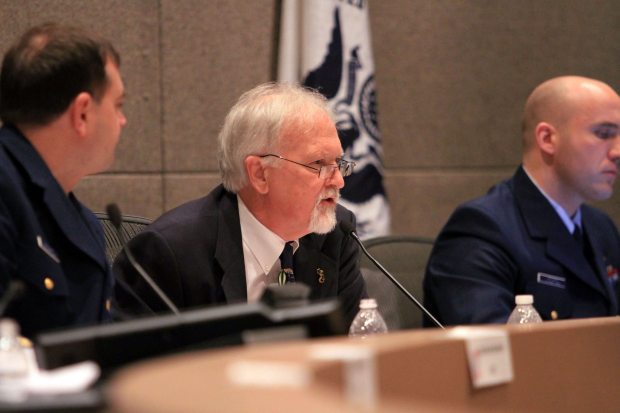In hindsight, manager of ill-fated Kulluk says 2 tugs were needed

Given the chance to do things differently, the rig manager for the Kulluk conical drilling unit would have used two powerful tug boats to ensure the rig made a safe winter crossing of the Gulf of Alaska last year.
That’s according to Todd Case, a 21-year Noble Drilling employee and the offshore installation manager who served as the manager of the Kulluk. He testified before the U.S. Coast Guard’s marine casualty investigation in Anchorage on Wednesday. Investigators are probing the incident that left the Shell drilling rig grounded on Sitkalidak Island near Kodiak on New Year’s Eve.
Case was the first person to testify who had been on scene during the Kulluk’s ill-fated journey through the Gulf of Alaska. He offered up brief but telling examples of the nasty conditions when the journey began to deteriorate in the final days of 2012.
MORE COVERAGE: Winter storm grounded Shell’s Arctic offshore drilling unit
Asked whether the crew ever felt their lives were in jeopardy as the stranded rig waited for assistance, Case said:
“There’s not much we could do except wait for other resources to get there,” he said. “We didn’t start crying.”
Case had spent two years with the Kulluk, and in that time had participated in two Kulluk tows. The Kulluk, a conical drilling unit and a centerpiece of Shell’s Arctic drilling operation, has no propulsion and must be moved using tug boats. The Aiviq, an almost new, Shell-owned tug, was specifically designed to escort the Kulluk.
Case testified that his first trip with the Kulluk came in the summer of 2012 and went from Dutch Harbor to Deadhorse, an effort to position the Kulluk for exploratory drilling in the Chukchi Sea. Despite rough weather along the way, that trip went well.
He called those seas “rough,” with the Kulluk pitching severely into waves, something that didn’t occur to such an extent in December. Still, lawyers pointed out during Case’s testimony that there was no problem with the towing system following the summer storm, despite the challenging weather.
‘All hell broke loose’
Case arrived in Dutch Harbor on Dec. 19, two days before the Kulluk was set to depart across the Gulf of Alaska to make off-season repairs near Seattle in preparation for the 2013 drilling season.
He worked with managers to make extensive preparations, and saw a four-day window of good weather. That convinced him, and managers, that it was time to go.
The Kulluk was manned with a skeleton crew, although Case couldn’t say why. Previous days’ testimony indicated that Shell required the Kulluk to be manned.
Case said the crew performed routine maintenance and made sure basic necessities – such as machine engines and boilers – kept operating for the comfort of the crew.
By all accounts, things progressed smoothly at first. On Christmas Day, Case said, the crew even had a barbecue on deck.
Before long, though, the situation deteriorated.
Bad weather rolled in – 30-foot seas and 50-knot winds. Case told investigators how the ship pitched 8 to 10 degrees at times, occasionally hitting 15 degrees.
That was important to note. According to the Kulluk’s manual, safety precautions needed to be taken when the ship tipped more than 6 degrees. Either the tow should be slowed or completely stopped. Case said the Kulluk slowed down, though it was unclear exactly when.
What was clear is that the shackle – a U-shaped piece of metal connecting the tow line to the rest of the Kulluk’s tow set up – snapped the morning of Thursday, Dec. 27.
Case said the towing crew was discussing changes to the tow plan with his supervisors – possibly moving to refuge or into deeper water – when he learned the shackle had snapped. At that point, “all hell broke loose.”
Waiting for relief
Case said the crew immediately set up the emergency tow line, and went about preparing for what to do next.
Investigators asked specifically about different plans for the Kulluk in distress – such as moving into deeper water or heading back to Dutch Harbor.
Case explained that neither of those would have worked. A trip back to Dutch Harbor would have taken three days and put the vessel right back into terrible weather. Heading deeper into the Gulf, on the other hand, would have taken the Kulluk out of search-and-rescue range – problematic if conditions worsened and the crew needed to be pulled off. That left the Kulluk crew looking find a place to “safe harbor” the vessels, while they waited for the Guardsmen and Nanuq – Shell-owned vessels – to make it on scene.
One attempt was made to evacuate the Kulluk crew on Dec. 28, but with helideck aboard the Kulluk swaying violently and a derrick on the Kulluk posing a threat for helicopters, there was no way to safely land.
Eventually the Guardsman arrived and connected to Aiviq, keeping the three vessels in line until the Nanuq was able to secure a second line to keep the Kulluk from drifting as much.
With the Nanuq on scene and connected to the Kulluk, the drift was arrested. That, along with somewhat calmer seas, gave Case and the crew time to stabilize the rig and evacuate via helicopter to Kodiak.
Alert tried to hang on
Capt. Rodney Layton of the Crowley-operated tug Alert testified how his ship tried to assist the Kulluk, saying that his ship could have held on to the Kulluk longer if Shell managers had not asked him to release it.
Layton said the Alert was able to connect to the Kulluk using the Nanuq’s lost line Monday night. That came after a series of connections between the rig and both the Aiviq and Nanuq had failed.
That left the Alert the last ship connected to the Kulluk. Fighting surging seas, it tried to hang on even though the Kulluk kept pulling the Alert, despite the tug’s efforts.
For a short period, Layton asked the Alert’s engine to run at 100 percent. Before long, though, a “summary shutdown” alarm sounded, warning the crew that the engines were too taxed.
Layton suspects someone alerted Unified Command about the alarm, because shortly afterwards he was told by John Kaighin, Shell’s Marine Manager, speaking through Unified Command, to cut the Kulluk loose.
Layton told the investigators that if given the chance, he would have had the Alert hold on to the Kulluk longer, though for how long was unclear.
“I probably would have tried to get it close to the beach and seen how those seas would have went,” he said. “There were some things I could have done.”
Day four of testimony continues tomorrow, with operators from Edison Chouest, builders of the Aiviq, scheduled to speak.
Contact Suzanna Caldwell at suzanna(at)alaskadispatch.com



